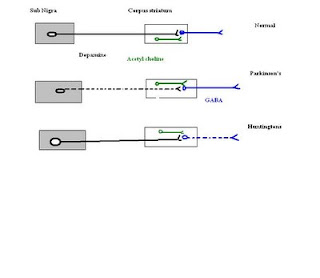Caudate nucleus
Putamen
Globus Pallidus
Substantia Nigra
Subthalamic nucleus (also known as the body of Luys)
Caudate nucleus and Putamen together are called corpus striatum; while Putamen and Globus pallidus together go by the name of lenticular nucleus. So much for the anatomy part. The way these nuclei communicate with each other, and with the brain and the spinal cord, is largely unknown. A probable wiring diagram, which is presently accepted (and quite complicated), is presented here. Red lines represent excitatory fibers; green lines inhibitory fibers.
Globus Pallidus interna (GPI), the internal segment of GP, secretes a chemical called gamma amino butyric acid or GABA for short. This is an inhibitory neurotransmitter, meaning that it will NOT allow neurons it supplies, to fire. As you can see, GPI inhibits PPN (pedunculo-pontine nucleus), the motor outflow to the brainstem and spinal cord. It also inhibits thalamus, which stimulates the brain through the thalamocortical circuit. Thus we see that GPI inhibits both the brain and the spinal cord.
 Now see that GPI itself gets inhibitory fibers from the striatum directly, via obviously the direct pathway. It also gets glutaminergic (also called glutamatergic) stimulatory (excitatory) fibers from the sub-thalamic nucleus (STN). But STN itself is inhibited by GABAergic fibers arising from GPE (globus pallidus externa) which again is inhibited by fibers from the striatum. (to make matters light, it reminds me of “seventh son of a seventh son”—by Iron Maiden!). Hence the net result through the second pathway (indirect pathway) is excitatory. So the direct pathway inhibits, while indirect pathway stimulates the GPI. (step1) Picture on the left.
Now see that GPI itself gets inhibitory fibers from the striatum directly, via obviously the direct pathway. It also gets glutaminergic (also called glutamatergic) stimulatory (excitatory) fibers from the sub-thalamic nucleus (STN). But STN itself is inhibited by GABAergic fibers arising from GPE (globus pallidus externa) which again is inhibited by fibers from the striatum. (to make matters light, it reminds me of “seventh son of a seventh son”—by Iron Maiden!). Hence the net result through the second pathway (indirect pathway) is excitatory. So the direct pathway inhibits, while indirect pathway stimulates the GPI. (step1) Picture on the left.But the things are not so easy. The guy out there called substantia nigra pars compacta (SNPC) secretes dopamine (the reward chemical). This substance is secreted in the striatum. Now dopamine combines with its receptor (a receptor is like a lover longing to unite, but not ignite, as we lovers do!!). In the direct pathway, it combines D1 receptor and stimulates. But it combines with D2 receptors on the neurons of the indirect pathway, and inhibits its outflow. Thus dopamine in effect inhibits GPI. (step2)
So what do we see now? Dopamine inhibits GPI (step1), which inhibits both the brain and the spinal cord. (step2) Thus dopamine EXCITES the brain and the spinal cord. (The final result)
 The above sequence operates normally. In Parkinsonism, the dopaminergic neurons die a slow death. As a result, the brain and spinal cord is inhibited and hypokinetic symptoms appear. Excitatory features like tremor are also present in Parkinsonism. Huntington’s chorea, another disease which involves this circuit, occurs due to destruction of GABA secreting neurons, as is shown in the adjoining picture. Notice the internuclear dopaminergic and intrastriatal cholinergic fibers. Hemiballismus (flailing movements of limbs) and athetosis (slow and writhing movements) are other manifestations of diseases of the basal ganglia.
The above sequence operates normally. In Parkinsonism, the dopaminergic neurons die a slow death. As a result, the brain and spinal cord is inhibited and hypokinetic symptoms appear. Excitatory features like tremor are also present in Parkinsonism. Huntington’s chorea, another disease which involves this circuit, occurs due to destruction of GABA secreting neurons, as is shown in the adjoining picture. Notice the internuclear dopaminergic and intrastriatal cholinergic fibers. Hemiballismus (flailing movements of limbs) and athetosis (slow and writhing movements) are other manifestations of diseases of the basal ganglia.Last modified: March 27, 2009
Reference: 1.William F Ganong, Review of medical physiology, 22nd ed., pp 213-217
2. Textbook of medical physiology, 11th ed., Guyton & Hall 707-712
2 comments:
There is an error in your comment at"so what do we see now?dopamin inhibits the brain and spinal cord" this is incorrect instead say "dopamin inhibits GPI which disinhits VLo of thalamus and PPN leading to facilitation of cortex (SMII or area 6)and SC. Dr.a.b.solepure
Thanks for your valued input Dr. Solepure, but this is actually what I wrote: "Thus dopamine EXCITES the brain and the spinal cord." In any case, the circuit is exceedingly complex and I only tried to make things rather simple. A more detailed discussion may be found in:
http://en.wikipedia.org/wiki/Basal_ganglia
Post a Comment